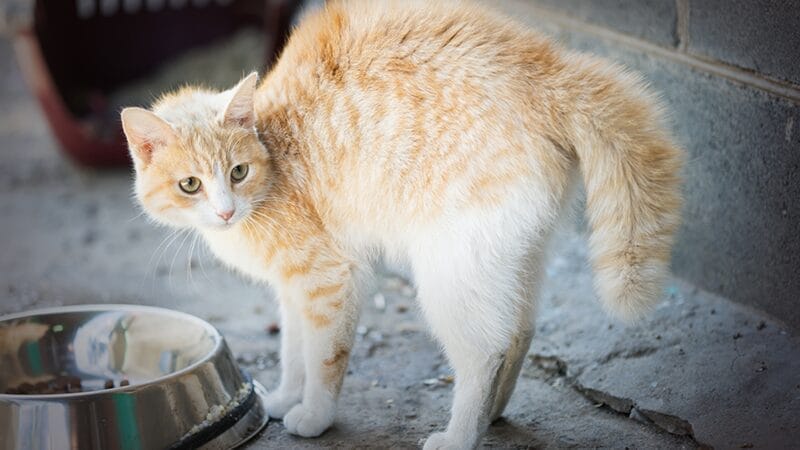Understanding Feline Hyperthyroidism: Causes, Signs, Diagnosis, and Treatment
Feline hyperthyroidism commonly occurs in older cats, affecting their metabolism. Learn the signs and treatment options.
Feline hyperthyroidism is a common endocrine disorder among middle-aged and older cats. It occurs when the thyroid glands, located in the neck, produce an excess amount of thyroid hormone. This hormone plays a crucial role in regulating the body’s metabolism, and its overproduction can lead to a variety of health issues. Learn the causes, signs, diagnosis, and treatment options, for cats with hyperthyroidism (overactive thyroid).

What is Feline Hyperthyroidism?
Hyperthyroidism in cats primarily affects their overall metabolism. The condition accelerates various bodily functions, leading to significant health issues. Nearly 10% of cats develop the disease, making it the most common endocrine disease in cats. Cats are usually over the age of 10, with no specific breed predispositions.
Causes of Hyperthyroidism in Cats
Most cases of feline hyperthyroidism in cats are caused by a benign mass (non-cancerous) on one or both thyroid glands. Rarely, the condition can be caused by malignant (cancerous) tumors. Some studies suggest environmental factors, such as diet, exposure to certain chemicals, and lifestyle, might increase the risk of developing hyperthyroidism, but clear connections have yet to be definitively proven.
Signs of Hyperthyroidism in Cats
The signs of hyperthyroidism in cats are generally related to an increased metabolism, the chemical reactions that occur in the body that turn food into energy. Signs your cat may have an overactive thyroid include:
- Weight loss, despite an increased appetite
- Hyperactivity or restlessness
- Increased heart rate
- Excessive thirst and urination
- Vomiting and diarrhea
- Poor grooming, resulting in poor coat condition
- Behavior changes like stress intolerance, panting, anxiousness, or irritability
- Increased vocalization
- Increased liver enzymes
If your cat exhibits any of these signs, consult with your family veterinarian. They may refer you to an internal medicine veterinary specialist with advanced training in endocrine disorders.

Diagnosing Hyperthyroidism in Cats
Diagnosis of hyperthyroidism is typically straightforward. Your veterinarian will conduct a physical examination and check your cat’s neck for an enlarged thyroid gland. Even when enlarged, these glands can be difficult to detect by touch. Blood tests will be needed to measure your cat’s thyroid hormones levels. Elevated levels of thyroxine (T4) usually confirm the diagnosis.
With the disease being so common in cats, your veterinarian may include a complete thyroid evaluation bloodwork panel during routine yearly lab work even if your cat isn’t showing any signs. Less commonly, a thyroid scan may be required to assess the size and shape of the thyroid gland and to detect possible tumors.
Treatment Options for Hyperthyroidism in Cats
Because the thyroid gland is overactive and causing too much T4, treatment is focused on decreasing hormone production and normalizing thyroid hormone levels.
Treatment options may include:
- Medication: Methimazole is a pill given orally that is inexpensive and very effective at treating the disease. However, it can be difficult to medicate some cats, and it does not cure the disease, so your cat would have to take the medication for the rest of their life. Most cats do not experience side effects from the medication, but side effects could include nausea, vomiting, lethargy, diarrhea, and facial rashes or lesions from your cat scratching. In some cases, there can be serious side effects such as low white blood cells or platelets, liver failure, or bleeding.
Compounded methimazole has become a good option for cats because methimazole is one of the few drugs that will successfully absorb through the skin. Cat ears are very thin, and an ointment-like medication readily absorbs in this area. Compounded medications (custom medication made for your pet by a specialized compounding pharmacy) are typically still a second choice given that custom medications often have a higher cost and there is a greater risk for variability in quality or drug content with custom medications. - Radioactive Iodine Therapy: Radioactive iodine treatment is a popular treatment option as it offers a more permanent resolution of hyperthyroidism. Your cat receives a one-time dose of radioactive iodine compound, called I-131, which selectively destroys the overactive thyroid tissue. Since the thyroid is the only place in the body that uses iodine, the I-131 compound accumulates in the abnormal thyroid tissue and emits ultra-short-range radioactivity to the thyroid gland nodule without affecting the rest of the body. It has a high success rate without the need for surgery and is curative in most cases.
- Dietary Therapy: Feeding a low-iodine diet can effectively suppress thyroid hormone production because iodine is essential for their formation. This diet is one of the most expensive prescription diets due to the intensive manufacturing process required to avoid iodine contamination. It can be used alone or in combination with other treatments. To maintain very low iodine levels, your cat must eat only this diet. No treats are allowed, and if there are other cats in the household, the cat on this special diet must be fed separately to ensure they don’t consume anything outside of their prescription diet, as even one bite can trigger thyroid hormone production. This diet does not cure the disease, so it must be continued for life. Additionally, some cats may already be on a special diet and cannot switch. Not all cats fully respond to the specialized diet, with about 83% achieving normal thyroid levels. Cats with higher starting thyroid hormone levels are less likely to reach normal levels, even if their hormone levels improve.
- Surgery: Surgery is occasionally used to treat hyperthyroidism, but the previously mentioned treatments are generally recommended due to their good outcomes and ease of administration. The most common reason for surgery is if thyroid cancer is suspected. However, surgery has potential downsides, including the need for anesthesia and the risk of damaging other structures in the neck. The biggest risk during surgery is the accidental injury of the parathyroid glands, which are located in the same area and share the same blood supply. This can lead to low calcium levels due to inadequate parathyroid hormone production (hypoparathyroidism). Anesthesia risks are typically higher if your cat is older or has other health issues.

Health Issues Associated with Hyperthyroidism
If left untreated, hyperthyroidism can lead to severe complications, including cardiomyopathy, high blood pressure, elevated liver enzyme ALT, unmasking of kidney disease, hypothyroidism, and hypoparathyroidism.
An enlarged heart or a normal-sized heart with excessively thickened heart muscles is commonly associated with hyperthyroidism. This occurs because the higher metabolism caused by the condition makes the heart work harder continuously. Fortunately, these heart changes are often reversible if the hyperthyroidism is successfully treated. Some cats may not show classic signs of hyperthyroidism, but the condition can be discovered during investigations into heart problems. Heart medications may be necessary until the hyperthyroidism is controlled.
Similarly, high blood pressure is associated with this condition and often contributes to heart enlargement. Some cats may need blood pressure medications until the hyperthyroidism is well controlled.
Another way hyperthyroidism can be diagnosed is through elevated ALT liver enzyme activity in bloodwork, even if the cat does not show classic signs of the disease. Hyperthyroidism is associated with increased ALT levels and is sometimes diagnosed while investigating changes in a cat’s liver values. Fortunately, this value should normalize with treatment.
Chronic kidney disease is very common in older cats (30% in cats over 10 years old). The high metabolism generated by hyperthyroidism can mask kidney disease by causing the kidneys to work harder. Normalizing thyroid levels will return kidney function to baseline, which may reveal a pre-existing low kidney function. It is important to check kidney values soon after starting treatment, as kidney disease management may need to be implemented after the thyroid condition is corrected. Rarely, this reduction in thyroid hormone levels can unmask serious renal failure. Despite this risk, treating hyperthyroidism is still recommended due to the whole-body implications of the disease.
Whenever altering a pet’s hormone levels, the aim is to achieve normal levels, but there is a chance the levels can drop below normal. In the case of the thyroid gland, the pet can become hypothyroid. If a cat is treated with methimazole, the dose can be adjusted, but with other treatments (e.g., I-131, surgery), the drop may be more permanent. A cat can take thyroid replacement if this develops, but efforts are made to avoid swapping one hormone disorder for another.
Prognosis for Cats with Hyperthyroidism
With appropriate treatment, the prognosis for cats with hyperthyroidism is generally positive. Most treatment options provide a way to control or cure the disease, allowing cats to live healthy lives. Regular follow-ups with your family veterinarian are important to monitor your cat’s overall health and adjust their treatment plan as needed.
Visit our Pet Care Resources library for more pet health and safety information.
FAQs
Learn More
Veterinary internal medicine specialists are trained to treat your pet’s complicated internal systems, including gastrointestinal tract, kidneys, central nervous system, and endocrine system.
Veterinary Internal MedicineContents
Learn More
Veterinary internal medicine specialists are trained to treat your pet’s complicated internal systems, including gastrointestinal tract, kidneys, central nervous system, and endocrine system.
Veterinary Internal Medicine


